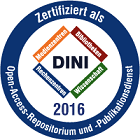SOX10 as a novel target in melanoma: a proteomics-based approach to expanding druggability

SOX10 as a novel target in melanoma: a proteomics-based approach to expanding druggability

| dc.contributor.advisor | Schmidt-Wolf, Ingo | |
| dc.contributor.author | Vordermark, Kira | |
| dc.date.accessioned | 2025-01-31T10:12:03Z | |
| dc.date.available | 2025-01-31T10:12:03Z | |
| dc.date.issued | 31.01.2025 | |
| dc.identifier.uri | https://hdl.handle.net/20.500.11811/12773 | |
| dc.description.abstract | Question: Advanced melanoma is a life-threatening condition with considerable metastatic potential for which the development of medical treatments is an area of critical need. Cysteine Druggability Mapping (CDM) is an innovative chemical proteomics-based approach able to identify cysteine residues which are amenable to small molecule inhibition. Performing CDM in a melanoma cell line unveiled a ligandable cysteine localized to the dimerization domain of factor SOX10. This study aimed to, first, examine the role of SOX10 regarding melanoma cell line growth, second, identify electrophilic compounds targeting SOX10, and third, investigate underlying mechanisms of action.
Methods: Cell proliferation following sgRNA-guided knockout of SOX10 was assessed using crystal violet assays. A luciferase reporter system was established in a melanoma cell line to perform a large-scale, high-throughput compound screen covering 1000+ electrophilic, covalent cysteine-reactive small molecules. Hits were defined as those compounds that decreased SOX10 transcriptional activity, which was read out through MITF promoter, and selected based on normalized cut-off values. Hits were validated by qPCR using SOX10 regulated genes. The compound´s mechanism of action was investigated using both endogenous SOX10 and pRK5-SOX10-Flag transfected into HEK293T. Oligonucleotide pulldown assays and co-immunoprecipitation assays were employed, and expression analyzed by Western Blot. Results: SOX10 depletion studies revealed significantly impaired cell growth in melanoma cell lines that strongly expressed SOX10, whereas those with weak SOX10 expression grew undisturbed. A small-molecule screen identified promising compounds which were validated in follow-up experiments. Studying structural analogs identified one top hit compound with increased potency. Downregulation of validated target genes following hit compound treatment proved its specificity. The ligand´s mechanism of action was found to be an increased SOX10-SOX10 interaction, resulting in disrupted signaling and growth defects. Conclusions: This study highlights SOX10´s role in melanoma proliferation leveraging CRISPR data. In addition, it offers a novel strategy to identify and validate covalent inhibitors by integrating proteomics data with a high-throughput screen and functional assays. | en |
| dc.language.iso | eng | |
| dc.rights | In Copyright | |
| dc.rights.uri | http://rightsstatements.org/vocab/InC/1.0/ | |
| dc.subject | Melanom | |
| dc.subject | Transkriptionsfaktor | |
| dc.subject | SOXE | |
| dc.subject | kovalente Inhibitoren | |
| dc.subject | Melanoma | |
| dc.subject | Chemical proteomics | |
| dc.subject | Covalent inhibitors | |
| dc.subject | Cysteine ligandability | |
| dc.subject | Transcription factor | |
| dc.subject | SOXE transcription factors | |
| dc.subject.ddc | 610 Medizin, Gesundheit | |
| dc.title | SOX10 as a novel target in melanoma: a proteomics-based approach to expanding druggability | |
| dc.type | Dissertation oder Habilitation | |
| dc.identifier.doi | https://doi.org/10.48565/bonndoc-494 | |
| dc.publisher.name | Universitäts- und Landesbibliothek Bonn | |
| dc.publisher.location | Bonn | |
| dc.rights.accessRights | openAccess | |
| dc.identifier.urn | https://nbn-resolving.org/urn:nbn:de:hbz:5-80892 | |
| dc.relation.doi | https://doi.org/10.1016/j.cell.2024.03.027 | |
| ulbbn.pubtype | Erstveröffentlichung | |
| ulbbnediss.affiliation.name | Rheinische Friedrich-Wilhelms-Universität Bonn | |
| ulbbnediss.affiliation.location | Bonn | |
| ulbbnediss.thesis.level | Dissertation | |
| ulbbnediss.dissID | 8089 | |
| ulbbnediss.date.accepted | 17.01.2025 | |
| ulbbnediss.institute | Medizinische Fakultät / Kliniken : Interdisziplinäre Zentren / Centrum für Integrierte Onkologie (CIO) | |
| ulbbnediss.fakultaet | Medizinische Fakultät | |
| dc.contributor.coReferee | Gkika, Eleni | |
| ulbbnediss.contributor.orcid | https://orcid.org/0009-0006-9042-6698 |
Files in this item
This item appears in the following Collection(s)
-
E-Dissertationen (1804)




